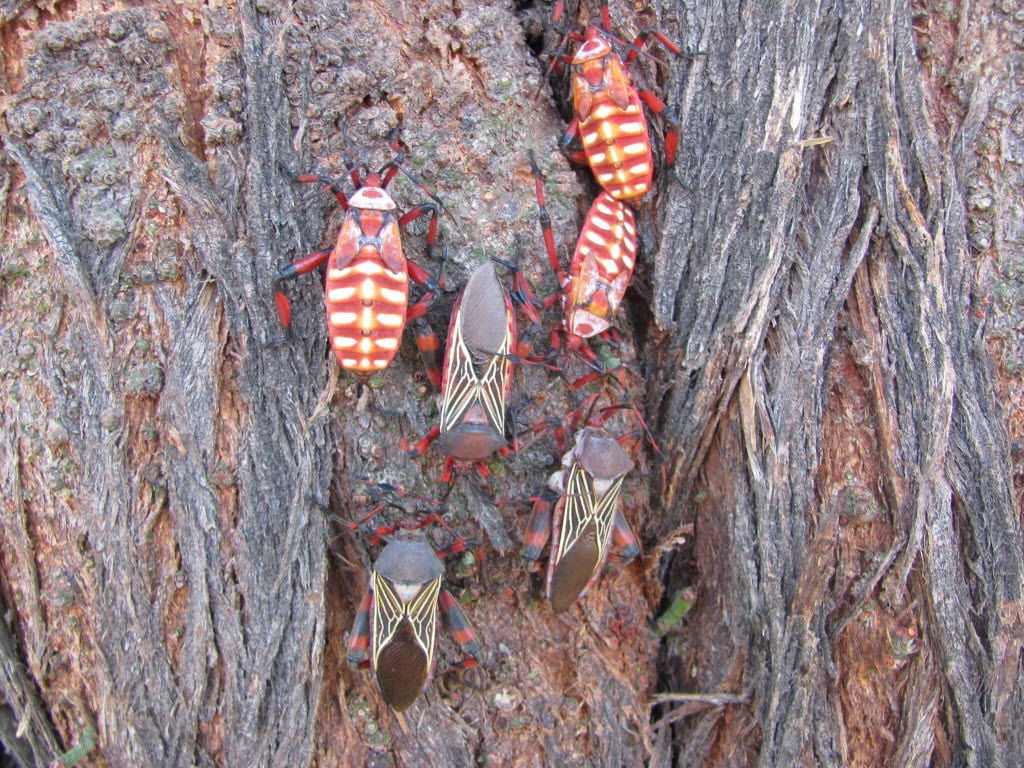Q: Can you identify this insect? It’s beautiful, gentle and somehow makes me think of an acoustic guitar. There are perhaps 30 of them in the main crook of a tree at my home.
Ar: These giant mesquite bugs (Thasus neocalifornicus) are a common sight in desert southwest landscapes, particularly on mesquite trees during May-August. These large bugs commonly aggregate in family groups and look impressive that way with their brightly colored nymphs. Despite their name, they may also be found on other garden and landscape plants.
They cause no significant plant damage, are harmless to humans, and do not have a venomous bite or sting so enjoy these bright highlights on our mesquite trees.
Q: I have five palm trees that were planted about 10 years ago and range from 10 to 20 feet tall. Out of five trees, only the largest one has this look about it at the base where the bark is peeling and spreading out near the ground level. What should I do about this problem?
A: I think there is no problem. As the root initiation zone on older palms expands up above the soil line, these new roots, which arise from tissue under the bark of the palm trunk, eventually force the bark outward in a flared fashion. This is a normal part of development as a palm matures, but the degree to which this bark flares out varies among palms.
Q: I am having landscaping done in my backyard in Marana. The landscaper is using non-potable water that is available for new plants and trees. He has also placed a waterline for non-potable water where my new garden will be. Will it be OK to consume fruits and vegetables grown with non-potable water, like watermelon?
A: I recommend using potable water for any edible plants you are growing, especially for any that will have the edible parts in contact with the ground where the water is being emitted such as watermelon, carrots, lettuce, etc. The Arizona Department of Water Quality has publications on the use of reclaimed and graywater on its website should you need more information.
Q: I have a fig tree and a pomegranate that I planted in 2012 in water harvesting basins. They both were thriving and last year I got great harvests from both with large and juicy fruits. They got supplemental water but mostly they got water two times a day from drip irrigation for 30-40 minutes in the a.m. and p.m. This year the fig got a lot of fruit but they were small and sort of dry, the pomegranate also got fruit but they are small and lots of them have split right in the middle and they have not reached maturity. The fig’s leaves were also turning yellow with some brown tips and falling off.
A: These trees do better with deep, infrequent watering instead of a little bit each day. The brown leaf tips are a sign of insufficient water and possibly salt damage from underwatering. The cure is to provide more water to wash the salt through the root zone. The small fruit and splitting could be attributed to the watering issue as well.
I am not sure how long ago you switched to the new watering schedule. It might take a while for the trees to show a lot of progress. This being their third year in the ground should have been the year they take off but they might have been set back a bit by the lack of water in the recent past. I say keep up the new watering schedule and see how they do.





